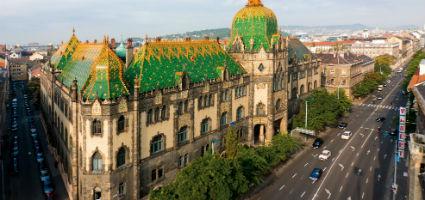 |
Address: 1091, Budapest Üllői út 33-37.
Phone number: (1) 456-5100
E-mail: info@imm.hu
Opening hours: A múzeum egész évben zárva tart.
|
The exhibition co-organized by the Museum of Applied Arts and the National Széchenyi Library presents 102 artistic posters which were shown with great success in Valencia, Spain in 2009, then in Seville. The exhibition was directed by the art historian Katalin Bakos.
The significant selection is now shown to the Budapest audience after five years. Such a large number of posters from the heydays of Hungarian poster art have never been shown in the framework of one exhibition in Hungary.
The Museum of Applied Arts presented selection is an extended version of the one shown in Spain, with small print, original poster designs added to the selection. Accessories from the era between the two wars, soap Flora, the soap Flóra, Modiano Cigarette Paper, the popular radio Standard with headphones and speakers, or the knitted Nor- Coc swimsuit to be seen, among others.
Objects of everyday life recall lifestyle in the twenties and thirties' modern metropolis, with various cultural programs, journeys and sports. Archive photos tell about the times whereas in a projection room contemporary newsreels can be watched, evoking the atmosphere of international fairs and the natural environment of the urban streets, the home of posters.
The protagonists of the exhibition however, are the posters themselves, which with their cavalcade of colors, striking forms represent Hungarian poster art at its best between WWI and WWII.
From the mid 1920s a completely new voice appeared on the Budapest scene. The dream world of art nouveau disappeared; representations of the humorous story telling were overshadowed. The air in the modern era surfaced and products began appearing on advertisements that were the products of developments in technology and served the comforts of modern urban life. Light bulbs, the radio, radio tube, a whole range of electric and gas appliances automobile tires, cans, fountain pen were seen on posters in an increasing number. Advertising of old goods - such as tobacco or fashion products, food, newspapers - were adapted to the new language of commercials, which was brought to life by the need of presenting new products in an adequate manner.
Lajos Kassák, Sándor Botnyik and Róbert Berény, who were leading figures in the unfolding avant-garde movement in the early 20th century in Hungary. They travelled to educate themselves to Vienna, Weimar and Berlin. Their posters gained great success for their simplicity, so modernist graphic took control in a wink of an eye. In 1930, the Museum of Applied Arts (the exact site of the current exhibition) held the début exhibition of the Hungary Book and Advertising Artists ' Society with Berényi, Bortnyik , Kassel, Laszló Moholy -Nagy and Farkas Molnar attended. Berény, Bortnyik, Kassák, Moholy-Nagy László Farkas Molnár attending it. The exhibition proved to be greatly influential. Hungarian design to graphic design, typography and posters reflected their work subsequently.







